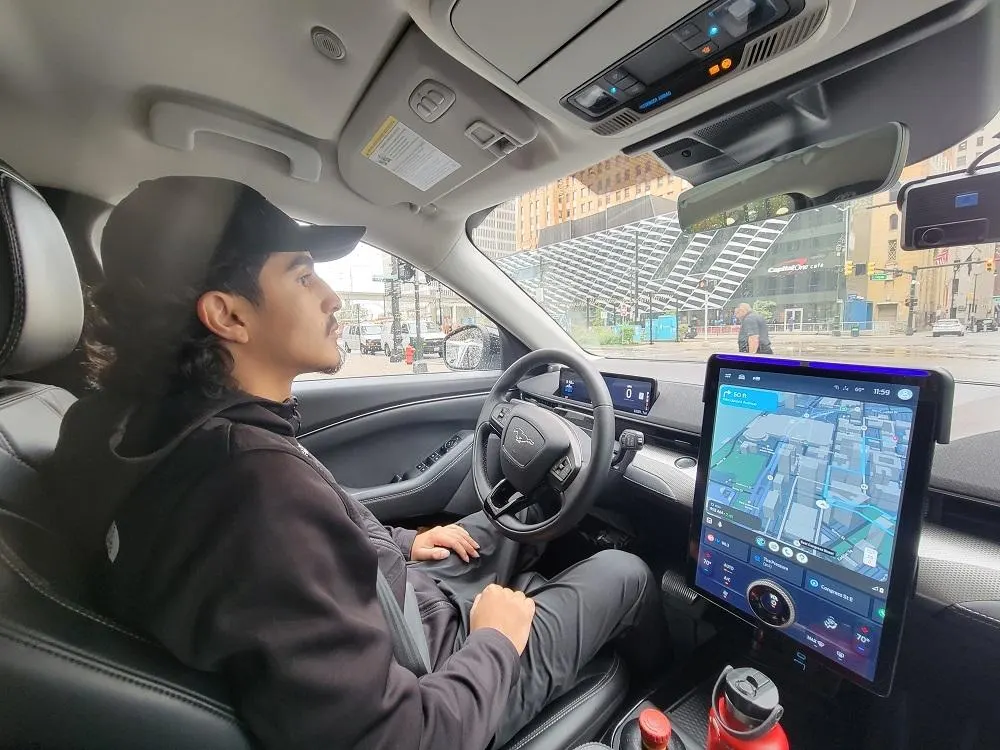By Ed Garsten,Senior Contributor
Copyright forbes

Wayve AI-based system aims to emulate human behavior in self-driving, or nearly, self-driving vehicles. System was demonstrated in Detroit on September 22, 2025.
On a rainy Monday in downtown Detroit a Ford Mustang Mach-E electric vehicle pulls away from the curb and dives into the work week traffic. There’s someone sitting behind the wheel but it’s strictly hands-off.
Dodging traffic, stopping for traffic lights, avoiding pedestrians and turning along a prescribed route the car just seems to “know” what to do.
Wayve AI Driver test car during test drive in downtown Detroit, Michigan on September 22, 2025.
Sounds like your stereotypical autonomous vehicle using a variety of sensors such as radar, cameras and lidar.
This vehicle, however is guided not only by the car’s internal cameras, but intelligence of the artificial variety using the Driver AI system by London-based Wayve Technologies Ltd.
It’s modeled like familiar generative AI platforms such as ChatGPT and its variations, said Wayve marketing director Rudi Rankin, during our test drive. The difference is it’s “learning” not by scrubbing the web, but by going to school by learning the “physics of the world” though data gathered from what Rankin described as “millions of hours of data supplied from our fleet as well as third party data fleets.”
MORE FOR YOU
The goal, she said, is to achieve the sort of nirvana engineers and scientists working on autonomous technology have long sought—emulating actual human behavior.
“It’s basically trained to mimic, to understand and mimic what human drivers do,” said Rankin. “We have various techniques where we can fine tune the model to really get to very expert like performance. But what that translates to in terms of the experience, the very sort of natural driving experience, it feels like there’s a human behind the wheel.”
At this point, though, Wayve’s AI Driver doesn’t replace the human behind the wheel, but rather enhances performance of advanced driver assistance technology, or ADAS, according to Rankin.
That’s how Nissan Motor Corporation plans to use AI Driver, announcing on September 22 it will combine it with its ProPilot advanced driver assistance systems beginning in 2027 in Japan.
Ride-hailing leader Uber is both a business partner and an investor in Wayve. The companies announced in June, they’ll develop and launch public-road trials of level four, fully autonomous vehicles in London combining Wayve’s AI technology and Uber’s global mobility network.
Indeed, AI is taking on a greater role on the world’s roads, just as different corners of the mobility industry find additional uses for the technology.
Panel discussing AI uses and challenges in the transportation industry at the MOVE America 2025 mobility conference in Detroit, Michigan, September 24, 2025.
It was certainly on the minds of panelists during several sessions as the just-completed MOVE America 2025 mobility conference in Detroit.
“Customers usually ask, how can you make my life easier? How can you make it more comfortable? How can you make it safer? And that’s what we’re looking at,” said Philipp Skogstad, president, CEO, Mercedes Benz during a panel on AI. “I think AI is a transformative enabling technology.”
Skogstad noted since Mercedes Benz brought Chat GPT into its vehicles three years ago customers are able to take advantage of an increasing scope of features aimed at fulfilling their request for an easier, more comfortable life.
“You can, as a customer now, access the entire Chat GPT knowledge domain in your vehicle while you’re riding,” Skogstad said. “From there we’re moving towards expanding comfort functions, having behavioral changes and then also helping you make your route more accessible.”
Private motorists aren’t the only drivers affected by the capabilities of AI. At shipping company DHL Transportation Solutions, AI is used to monitor and evaluate driver behavior, pointed out Jennifer Miller, vice president, integrated transportation solutions.
“We want to prevent the accidents before they happen, change the behavior, make our drivers safer, make sure they come home, make the general public safer,” said Miller. “It’s really important to us, and that type of AI is continuing to evolve, and we’re really, really using it every single day in all of our trucks.”
As AI does evolve, the challenge for mobility companies is to keep up with that evolution to remain competitive, warned Edwin Olson, CEO of May Mobility, which provides robotransit vehicles in several U.S. cities.
“Today we see on most AV companies building technology that looks a lot more like ChatGPT 3.5 two years ago,” Olson said during a panel on autonomous vehicles. “So I think the next big culling in the space is going to be AV companies like us, who are able to bring that next generation of recent AI systems onto cars, because that fundamentally makes the cars cheaper and better at operating in environments that are outside of their original database.”
Which brings us back to our drizzly ride around downtown Detroit in the Wayve AI Driver test car, part of a road trip that’s already visited more than 400 locations on three continents in the past six months.
The drives are aimed not only at educating reporters, but educating the AI system about myriad different things it needs to know including the road conditions, how drivers in each region behave, lighting and weather conditions, according to Rankin.
In the end, it’s artificial intelligence aimed at acting as human as possible to keep actual human drivers safe.
Editorial StandardsReprints & Permissions



